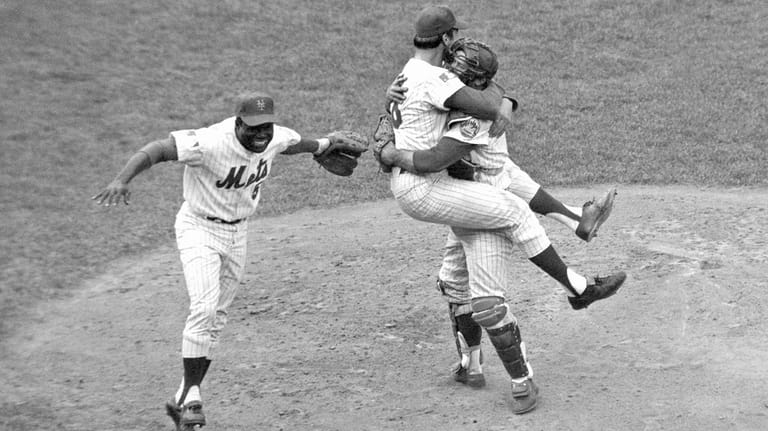There's no 1969 World Series for the Mets without Jerry Grote
Mets catcher Jerry Grote signs an autograph book at Shea Stadium on Sept. 29, 1969. Credit: Newsday/Don Jacobsen
It takes all kinds, and the 1969 Mets had them, from the glamorously terrific Tom Seaver to the scrappy Bud Harrelson to all manner of kids, veterans, role players and indispensable cogs in between.
But Jerry Grote stood alone, both as the behind-the-plate anchor for a young, talented pitching staff and for his personality.
He was a rough-around-the-edges Texan whose grit and grouchiness could irritate everyone from opponents to sportswriters to even teammates, and it was an essential part of that team’s Amazin’ run to a world championship.
In hockey, they call it “sandpaper.” That is a loaded term in pitching and catching circles, of course, but it fits here. Grote was an abrasive who polished a gem.
By the time he died at 81 on Sunday — back home in Texas, naturally — he had become a historical footnote for most younger Mets fans, but not to those who watched him play, or played with or against him.
“He was the reason for my success,” pitcher Jerry Koosman said in comments from Grote’s teammates released by the Mets. “I am heartbroken. No one was better behind the plate.”
Shortly after Cleon Jones caught Davey Johnson’s fly ball to end the ’69 World Series, Grote caught Koosman on the mound in a leaping, celebratory hug that became an iconic image of that day.

Mets catcher Jerry Grote, right, embraces pitcher Jerry Koosman as Ed Charles, left, joins the celebration after the Mets defeated the Baltimore Orioles in the Game 5 to win the World Series at Shea Stadium on Oct. 16. 1969 Credit: AP
“Jerry was a bulldog,” Jones said. “He was the glue that kept the staff together.”
But the most telling testimony about Grote’s skill came from opponents, notably including the man widely considered the greatest defensive catcher of that era.
“Johnny Bench once told me, ‘If [Grote] was on the Reds, I would be playing third base,’ ” Ed Kranepool said.
Grote came to the Mets from the Houston Colt 45s organization in 1966, seemingly miscast as a New Yorker. He eventually came to embrace the area, living happily in Manhasset. But unlike other Mets of the era who chose to settle here, that never was in Grote’s plans.
Jerry Koosman, left, and Jerry Grote walk onto the field for the Mets' World Series 50th anniversary ceremony at Citi Field on June 29, 2019. Credit: Kathleen Malone-Van Dyke
In a 1975 interview with Newsday, when he was 32, he already was pining for a return to Texas, where he had a 350-acre ranch waiting for him near a town called Smiley.
He remembered a call he had gotten from his father, Clarence.
“He asked me how I was feeling, and I said, ‘I’m feeling damn ornery,’ ” Grote said at the time. “He said, ‘Well, I’ve got a pick, a shovel and a hole that will fix that right up.’ Dad really knows me.”
Grote went on to play for the Mets into 1977, then the Dodgers in 1977 and 1978, then made a brief comeback in 1981 with the Royals and Dodgers. But even in 1975, the grind of snagging balls in the dirt and of baseball travel were getting to him.
“I think after the ’69 season, a lot of the sheer desire went out of it for me,” he said. “That’s when it really started to become a job, after that.
Perhaps, but he hid it well, helping the Mets win another pennant in 1973 and getting his second All-Star nod in ’74.
Grote joined his old teammates in 2019 for the 50th anniversary of that first championship, which he relished. He walked onto the field by Koosman’s side.
Even given the actuarial charts for men in their age group, the ’69 Mets have been hit unusually hard by death and poor health.
Mets radio announcer Howie Rose posted on “X,” “We’ve now lost ten players who were on the 1969 World Series roster, plus the owner, manager, general manage⁄r and the entire coaching staff.
“Yes, it’s been 55 years and yes, it’s the circle of life, but it’s still painful. Cherish the memories.”
To forge those memories in 1969, everything had to go right for the Mets. It began at the beginning: behind home plate.
“Without Jerry, we don’t win in 1969,” Art Shamsky said. “It’s as simple as that. He was the best.”

